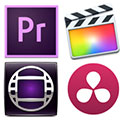
In the aftermath of IBC 2013 I wrote about the inevitable convergence of various software packages. It was easy to see how various vendors began expanding their packages into areas beyond the primary intended roles. NAB 2014 confirms this ongoing trend, and breeds more and more interesting solutions at various price ranges.
Let’s quickly sum it up: BlackMagic Design gave Resolve a serious boost in the editing realm and collaboration, The Foundry announced Nuke Studio, bringing Hiero timeline into Nuke – or another way around, if you prefer – upping the VFX management expectations for everyone and aiming towards the on-line market. Autodesk enhanced real-time timeline capabilities in both Flame and Smoke, while Adobe is constantly tightening the interaction between its various applications to make them work seamlessly as one. The case can be made that Avid is also attempting to do precisely that, gathering all its offerings in Avid Everywhere platform mirroring Adobe Anywhere though with proxy workflow instead of real-time server rendering.
All in all, this expansion outside the primary areas suggests that the applications are mostly mature, the toolset required to fulfil the primary functions is pretty much there, and the software companies are aggressively attempting to widen the user base. This is the case especially with grading packages, where the competition is relatively intense, and the high-end segment stops being perceived as the only viable support. Witness Digital Vision licensing its precision control surface to SGO Mistika, and going software-only route with its Nucoda, dropping its price in a clear attempt to widen its reach.
Which breeds the question – is specialized software doomed to fail in the long run? Will the likes of Baselight eventually run off of the resources to sustain themselves? Certainly, there are some comfortable niches where individual applications do and will exist – Mocha for planar tracking and Silhouette for rotoscoping seem to be pretty good examples. But they thrive in the space where they have no competition, protected by patents or relative obscurity. It’s a very cozy place to be in, but there are not many like these. How will Nuke fare against Mamba FX, now that it has Mac version? How will Premiere, Avid and FCPX survive the BlackMagic incursion?
Today for pure editing still nothing beats dedicated NLEs. I bet it might be a year or two before somebody attempts to do a larger editing project in Nuke Studio or Resolve. But I can easily see how shorter forms might resort to these tools, especially to Resolve for its unbeatable price point and relative ease of use, and Nuke Studio will comfortably find its place in the VFX editorial and possibly finishing.
Lastly, there is the problem of feature bloat and discoverability. When software starts to expand into areas not envisioned from the moment of its conception, the risk of hitting a development wall is pretty huge, since the base code and the user interface was not optimized for these additional tasks, and the forays will most likely appear clumsy to the eyes of the users of specialized packages. Nuke will never be as good roto software as is Silhouette, and I highly doubt it will outclass After Effects in motion graphics.
Will the convergence happen though? Will there be enough overlap between Adobe Creative Cloud, Nuke Studio, Autodesk Flame, and daVinci Resolve that the choice will come down to user preference and – gosh – pricing? Not unless BlackMagic partners with SGO, Eyeon or takes over Toxik from Autodesk. If that happens, all bets are off.
As for now, we can happily choose any tool we deem appropriate for the job and out budgets.





